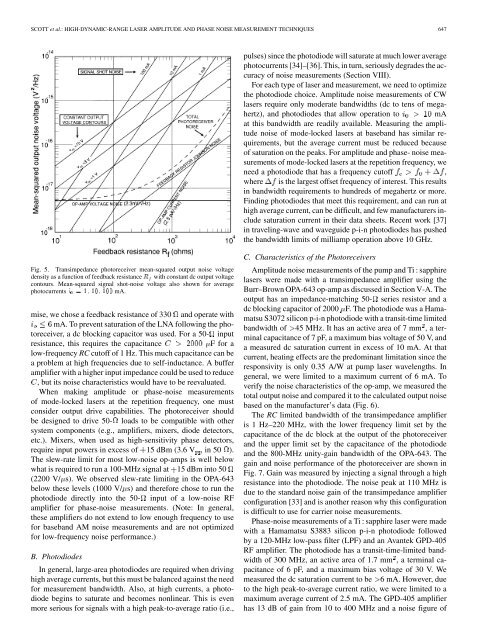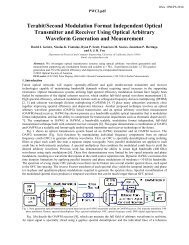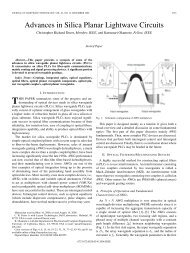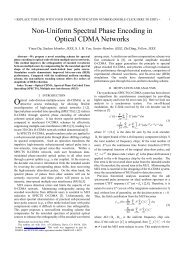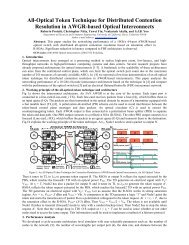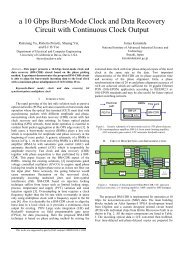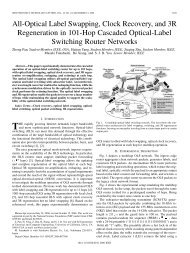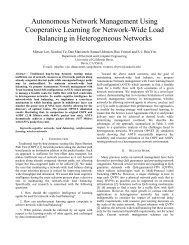High-Dynamic-Range Laser Amplitude and Phase Noise - Next ...
High-Dynamic-Range Laser Amplitude and Phase Noise - Next ...
High-Dynamic-Range Laser Amplitude and Phase Noise - Next ...
Create successful ePaper yourself
Turn your PDF publications into a flip-book with our unique Google optimized e-Paper software.
SCOTT et al.: HIGH-DYNAMIC-RANGE LASER AMPLITUDE AND PHASE NOISE MEASUREMENT TECHNIQUES 647<br />
pulses) since the photodiode will saturate at much lower average<br />
photocurrents [34]–[36]. This, in turn, seriously degrades the accuracy<br />
of noise measurements (Section VIII).<br />
For each type of laser <strong>and</strong> measurement, we need to optimize<br />
the photodiode choice. <strong>Amplitude</strong> noise measurements of CW<br />
lasers require only moderate b<strong>and</strong>widths (dc to tens of megahertz),<br />
<strong>and</strong> photodiodes that allow operation to mA<br />
at this b<strong>and</strong>width are readily available. Measuring the amplitude<br />
noise of mode-locked lasers at baseb<strong>and</strong> has similar requirements,<br />
but the average current must be reduced because<br />
of saturation on the peaks. For amplitude <strong>and</strong> phase- noise measurements<br />
of mode-locked lasers at the repetition frequency, we<br />
need a photodiode that has a frequency cutoff ,<br />
where is the largest offset frequency of interest. This results<br />
in b<strong>and</strong>width requirements to hundreds of megahertz or more.<br />
Finding photodiodes that meet this requirement, <strong>and</strong> can run at<br />
high average current, can be difficult, <strong>and</strong> few manufacturers include<br />
saturation current in their data sheets. Recent work [37]<br />
in traveling-wave <strong>and</strong> waveguide p-i-n photodiodes has pushed<br />
the b<strong>and</strong>width limits of milliamp operation above 10 GHz.<br />
Fig. 5. Transimpedance photoreceiver mean-squared output noise voltage<br />
density as a function of feedback resistance R with constant dc output voltage<br />
contours. Mean-squared signal shot-noise voltage also shown for average<br />
photocurrents i =1; 10; 100 mA.<br />
mise, we chose a feedback resistance of 330 <strong>and</strong> operate with<br />
mA. To prevent saturation of the LNA following the photoreceiver,<br />
a dc blocking capacitor was used. For a 50- input<br />
resistance, this requires the capacitance<br />
F for a<br />
low-frequency RC cutoff of 1 Hz. This much capacitance can be<br />
a problem at high frequencies due to self-inductance. A buffer<br />
amplifier with a higher input impedance could be used to reduce<br />
, but its noise characteristics would have to be reevaluated.<br />
When making amplitude or phase-noise measurements<br />
of mode-locked lasers at the repetition frequency, one must<br />
consider output drive capabilities. The photoreceiver should<br />
be designed to drive 50- loads to be compatible with other<br />
system components (e.g., amplifiers, mixers, diode detectors,<br />
etc.). Mixers, when used as high-sensitivity phase detectors,<br />
require input powers in excess of 15 dBm (3.6 V in 50 ).<br />
The slew-rate limit for most low-noise op-amps is well below<br />
what is required to run a 100-MHz signal at 15 dBm into 50<br />
(2200 V/ s). We observed slew-rate limiting in the OPA-643<br />
below these levels (1000 V/ s) <strong>and</strong> therefore chose to run the<br />
photodiode directly into the 50- input of a low-noise RF<br />
amplifier for phase-noise measurements. (Note: In general,<br />
these amplifiers do not extend to low enough frequency to use<br />
for baseb<strong>and</strong> AM noise measurements <strong>and</strong> are not optimized<br />
for low-frequency noise performance.)<br />
B. Photodiodes<br />
In general, large-area photodiodes are required when driving<br />
high average currents, but this must be balanced against the need<br />
for measurement b<strong>and</strong>width. Also, at high currents, a photodiode<br />
begins to saturate <strong>and</strong> becomes nonlinear. This is even<br />
more serious for signals with a high peak-to-average ratio (i.e.,<br />
C. Characteristics of the Photoreceivers<br />
<strong>Amplitude</strong> noise measurements of the pump <strong>and</strong> Ti : sapphire<br />
lasers were made with a transimpedance amplifier using the<br />
Burr–Brown OPA-643 op-amp as discussed in Section V-A. The<br />
output has an impedance-matching 50- series resistor <strong>and</strong> a<br />
dc blocking capacitor of 2000 F. The photodiode was a Hamamatsu<br />
S3072 silicon p-i-n photodiode with a transit-time limited<br />
b<strong>and</strong>width of 45 MHz. It has an active area of 7 mm , a terminal<br />
capacitance of 7 pF, a maximum bias voltage of 50 V, <strong>and</strong><br />
a measured dc saturation current in excess of 10 mA. At that<br />
current, heating effects are the predominant limitation since the<br />
responsivity is only 0.35 A/W at pump laser wavelengths. In<br />
general, we were limited to a maximum current of 6 mA. To<br />
verify the noise characteristics of the op-amp, we measured the<br />
total output noise <strong>and</strong> compared it to the calculated output noise<br />
based on the manufacturer’s data (Fig. 6).<br />
The RC limited b<strong>and</strong>width of the transimpedance amplifier<br />
is 1 Hz–220 MHz, with the lower frequency limit set by the<br />
capacitance of the dc block at the output of the photoreceiver<br />
<strong>and</strong> the upper limit set by the capacitance of the photodiode<br />
<strong>and</strong> the 800-MHz unity-gain b<strong>and</strong>width of the OPA-643. The<br />
gain <strong>and</strong> noise performance of the photoreceiver are shown in<br />
Fig. 7. Gain was measured by injecting a signal through a high<br />
resistance into the photodiode. The noise peak at 110 MHz is<br />
due to the st<strong>and</strong>ard noise gain of the transimpedance amplifier<br />
configuration [33] <strong>and</strong> is another reason why this configuration<br />
is difficult to use for carrier noise measurements.<br />
<strong>Phase</strong>-noise measurements of a Ti : sapphire laser were made<br />
with a Hamamatsu S3883 silicon p-i-n photodiode followed<br />
by a 120-MHz low-pass filter (LPF) <strong>and</strong> an Avantek GPD-405<br />
RF amplifier. The photodiode has a transit-time-limited b<strong>and</strong>width<br />
of 300 MHz, an active area of 1.7 mm , a terminal capacitance<br />
of 6 pF, <strong>and</strong> a maximum bias voltage of 30 V. We<br />
measured the dc saturation current to be 6 mA. However, due<br />
to the high peak-to-average current ratio, we were limited to a<br />
maximum average current of 2.5 mA. The GPD-405 amplifier<br />
has 13 dB of gain from 10 to 400 MHz <strong>and</strong> a noise figure of


